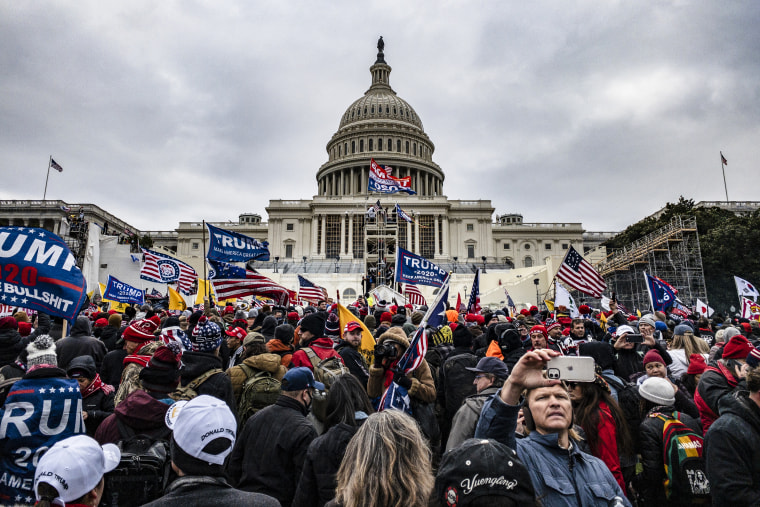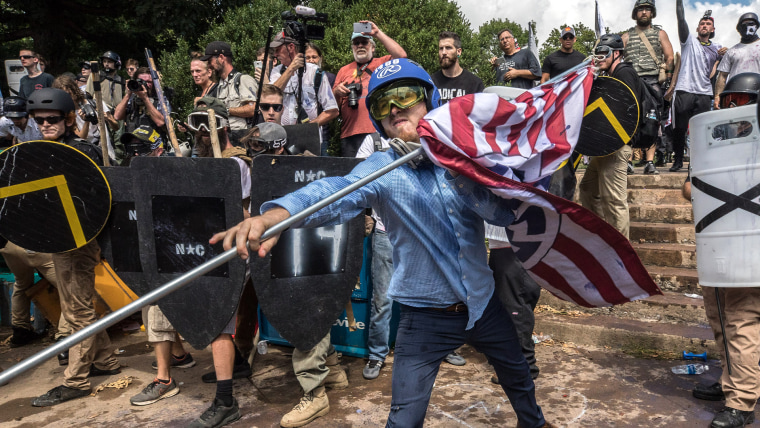Investigators for the House Jan. 6 committee are scrutinizing rallies and events as far back as a year before the Capitol riot in an effort to identify a broader network of planning and the causes of the attack, according to a half-dozen people helping conduct the committee’s investigation who spoke with NBC News.
The committee’s investigators are zeroing in on events attended by members of domestic extremist movements like the Proud Boys and Oath Keepers in 2020. Those events include Covid lockdown protests, counterprotests to some racial justice demonstrations, armed protest activity focused on state Capitols across the U.S., and “Stop the Steal” rallies that occurred prior to Jan. 6, 2021.
The goal, according to several of the investigators who spoke with NBC News, who requested anonymity to discuss the ongoing investigation, is to determine whether these earlier events were “proving grounds,” opportunities to network, or places to encourage one another to “cross red lines” into future violence.

The investigators, who are lawyers hired by the House committee, were specifically assigned to identify links to and causes of domestic violent extremist movements on the day of and run-up to Jan 6. They detailed broad themes about what is likely to be revealed in an upcoming committee report and public hearings, which have yet to be scheduled.
The House committee is several months into an investigation of the Jan. 6 attack and the events that led up to it. The committee has subpoenaed a wide variety of politicians and allies of former President Donald Trump. It remains unclear what the end goal is for the committee and whether it ultimately plans to recommend that the Department of Justice press charges based on evidence unearthed, or if it will simply conduct hearings and provide a report to inform the public.
The revelation of details of the House committee’s investigation come as federal law enforcement agencies remain on alert for domestic terrorism. The Department of Homeland Security issued an advisory Monday saying that the U.S. “remains in a heightened threat environment fueled by several factors, including an online environment filled with false or misleading narratives and conspiracy theories, and other forms of mis- dis- and mal-information (MDM) introduced and/or amplified by foreign and domestic threat actors.”
The investigators said the domestic extremism investigation is separated into two teams differentiated mostly by timeline.
The “red team” is largely concentrating on the events that took place on Jan. 6. The “purple team” is mostly focused on how anti-democratic coalitions formed in the months before the Jan. 6 riot, and how they have evolved in the year since.
The two groups have been working together to determine if extremist groups coordinated with other militia movements, rally organizers and government officials in the weeks before the Capitol riot.
The committee has interviewed members and leaders of the extremist movements, including the recently indicted Oath Keepers leader Stewart Rhodes, who participated in a video conference with investigators last week.
The committee has also subpoenaed high-profile conspiracy theorists like radio host Alex Jones and prominent white nationalists, like America First founder Nick Fuentes and Patrick Casey, who were present on Capitol grounds on Jan. 6.
One wider goal is to determine how groups with seemingly disparate ideals — such as believers in broad conspiracy movements like QAnon, as well as more narrowly defined militias like the Oath Keepers — had what appeared to be a shared goal of storming the Capitol on Jan. 6.
One unifying factor for many groups, investigators said, was belief in the great replacement theory, a white nationalist conspiracy theory that falsely claims shadowy elites are intentionally displacing white Americans through immigration.
The theory is tied to major white supremacist demonstrations, like the 2017 Charlottesville “Unite the Right” march in Virginia, and was cited in the manifestos and online posts of four white supremacist mass shooters in 2018 and 2019 who left a total of 86 dead.

The House committee’s investigation is separate from the ongoing Department of Justice investigation into the rioters, which produced seditious conspiracy charges against 11 Oath Keepers last month for their role in the riot.
Investigators stressed that their mandate is “bigger and broader” than the DOJ’s scope, and aims to answer both specific questions about coordination on Jan. 6 and also how the movements are evolving after the riot as a way to identify future attacks.
They are also exploring the federal law enforcement failures that led agencies like the Department of Homeland Security and the FBI to underplay the threat in the run-up to riot.
Investigators are asking whether the threat was defined too narrowly by federal law enforcement officials by focusing on specific groups like the Proud Boys or Oath Keepers, whose membership fluctuates, while a broader anti-government movement spread throughout the U.S. and world.
The committee is determining whether the federal government should be looking at the threat of domestic violent extremism differently — less as distinct militia movements, and more as “one more organizationally potent threat,” underpinned by anti-elite ideology, an investigator said.